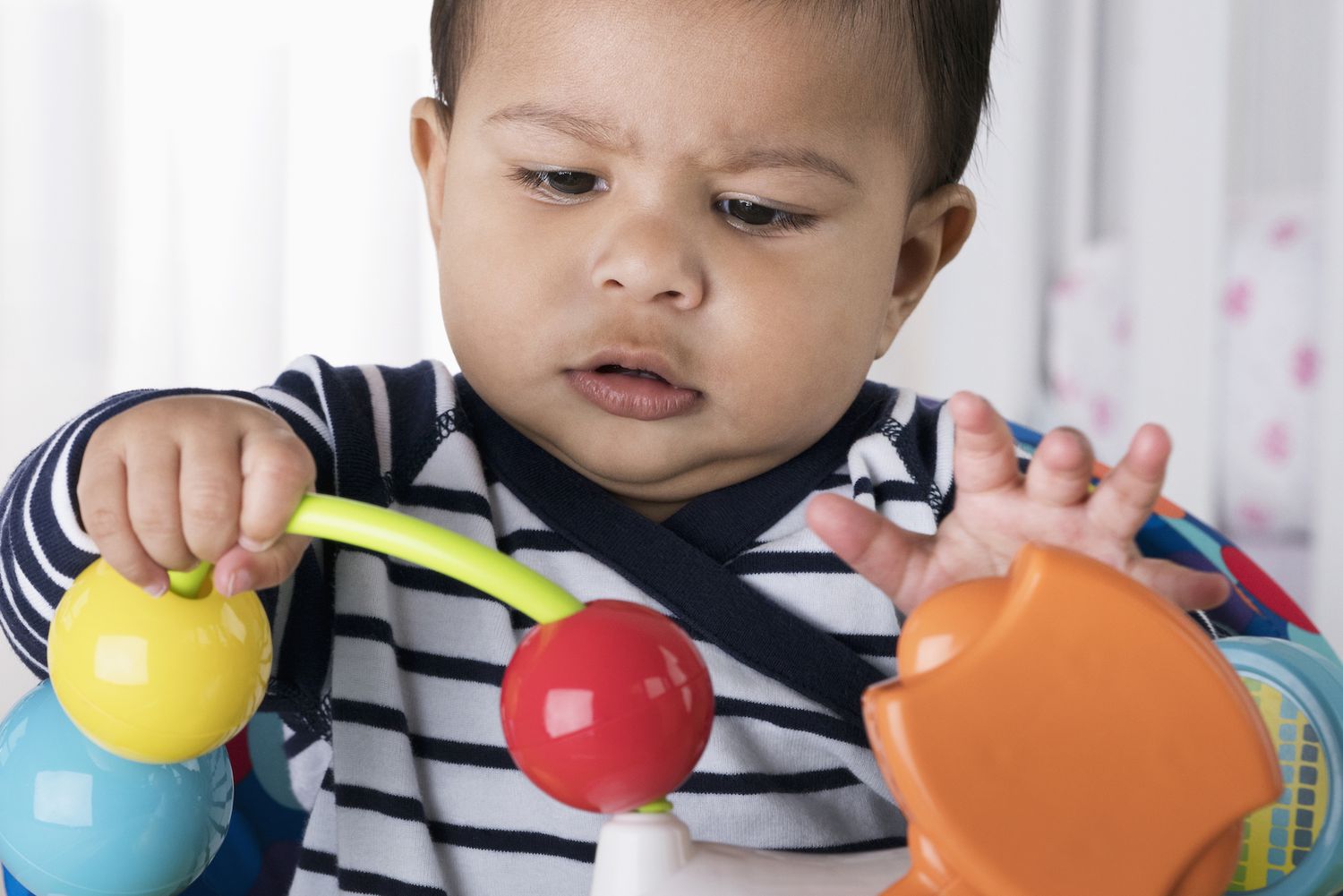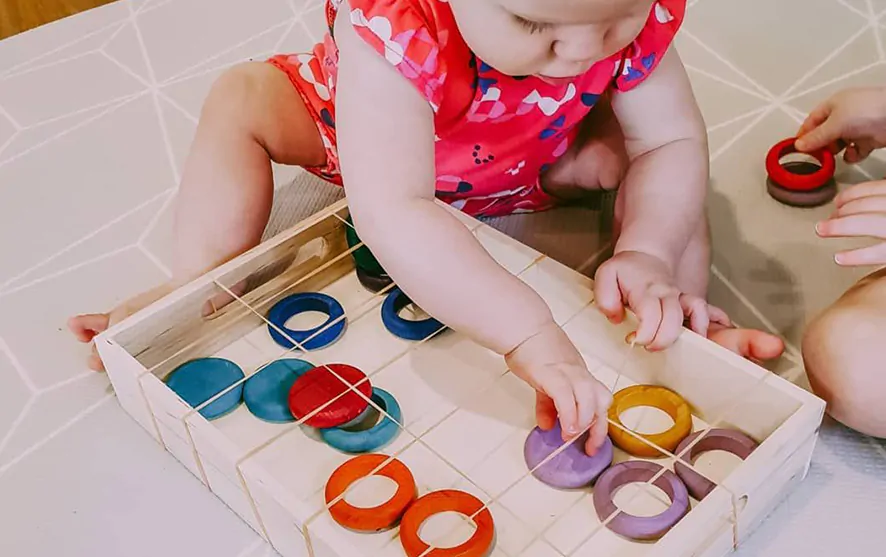When Do Babies Grab Toys? A Developmental Journey of Reaching and Play
The world of a newborn is a whirlwind of fascinating sensations. Every touch, sound, and sight is a captivating discovery. But when does this exploration translate into play with toys? While there’s no single answer, this article delves into the developmental stages that lead to playful interactions with objects.
From Reflexes to Reaching: The Early Months (0-3 Months) – A World of Fascinating Discoveries
The first three months of a baby’s life are a whirlwind of incredible change. Though they may seem like tiny bundles of sleep and snuggles, these early months lay the groundwork for future play and exploration. Here’s a closer look at the developmental milestones that pave the way for joyful interactions with toys:
The Power of Reflexes:
Newborn babies are driven by a set of primitive reflexes. The grasp reflex, for instance, causes them to clench their tiny fists around anything placed in their palm. This isn’t intentional grasping yet, but it’s a crucial starting point. Similarly, the rooting reflex helps them find a nipple for feeding. These early reflexes provide a foundation for more purposeful movements to come.
Sensory Exploration Begins:
While grabbing toys may not happen right away, newborns are actively taking in the world around them through their senses. They are drawn to high-contrast patterns, finding comfort in black and white mobiles or bold stripes on a blanket. Mobiles with simple shapes and gentle music can capture their attention and stimulate their developing vision and hearing.
The Soothing Power of Familiarity:
Newborns find comfort in familiar faces and voices. They may turn their heads towards the sound of their caregiver’s voice or nuzzle closer for a comforting touch. This early preference for familiar sights and sounds translates into a fondness for specific toys later on. A soft, cuddly blanket with a familiar scent or a musical mobile with a calming melody can become a source of security and comfort.
Building the Foundation for Play:
Even though they might not be reaching for toys yet, these early months are crucial for building the foundation for future play. As babies develop head control, they can begin to track objects with their eyes. This eye-hand coordination is a vital building block for reaching and grasping later on. By providing opportunities for safe exploration – tummy time on a colorful play mat or gentle rattles with interesting textures – you can stimulate their senses and encourage their natural curiosity.
While grabbing toys might not happen overnight, the first three months are filled with remarkable developmental leaps. By understanding these early milestones, you can create a nurturing environment that fosters a love for exploration and paves the way for joyful interactions with toys in the months to come.
Exploring Through Senses: The Second Trimester (4-6 Months)
The 4-6 month period is a time of rapid development for babies. They gain greater control over their head and neck, allowing them to observe their surroundings with laser focus. This newfound ability, coupled with improved grasping and hand-to-hand coordination, fuels their desire to explore everything within reach. Sensory play takes center stage during this exciting phase.
A Symphony of Textures and Sounds
Babies at this age become fascinated by the world around them, and their senses are the primary tools for exploration. Mouthing objects becomes a favorite pastime – it’s a way to learn about textures, shapes, and tastes. They delight in shaking rattles, banging toys on surfaces, and crinkling soft books. These seemingly simple actions are actually quite complex, requiring hand-eye coordination and cause-and-effect understanding.
A World of Color and Contrast
During this stage, babies are particularly drawn to toys with contrasting colors, textures, and sounds. A black and white mobile with dangling objects of different textures provides endless entertainment. They become captivated by brightly colored toys with rattles, bells, or crinkles – the visual and auditory stimulation fuels their curiosity.
Interactive Gyms and Engaging Books
Activity gyms become a haven for exploration. Babies love to bat at dangling toys, swat at mirrors, and reach for colorful shapes. Board books with high-contrast pictures spark their interest in visual storytelling. Simple, repetitive songs sung in a playful voice capture their attention and promote language development.
The Power of Caregiver Interaction
While babies are busy exploring independently, playtime is even more enriching with caregiver interaction. Narrate your actions as you change a diaper or get them dressed. Point out interesting objects during walks or playtime. Respond to their babbles and gurgles with enthusiasm. This back-and-forth communication strengthens the parent-child bond and fosters a love of learning through play.
Intentional Grasping and Exploration: The Second Half of the First Year (6-12 Months)
Around 6 months, babies enter a whole new world of play. They develop object permanence, the understanding that objects continue to exist even when out of sight. This newfound knowledge fuels their desire to explore cause and effect. They experiment with dropping objects, pushing buttons, and making sounds with toys.
Sitting independently allows them to interact with toys in new ways. They can stack and unstack blocks, roll balls, and put objects in and out of containers. Pretend play begins to emerge as they mimic actions they see around them, such as talking on a phone or feeding a doll. Simple toy cars, stuffed animals, and nesting cups become their tools for exploration and imagination.
Choosing the Right Toys for Each Stage
While there’s no one-size-fits-all answer to when babies start grabbing toys, understanding their developmental stages helps you choose age-appropriate options. Here’s a quick guide:
- Newborns to 3 Months: Opt for high-contrast mobiles, soft rattles, and crinkly books.
- 4-6 Months: Look for activity gyms, textured balls, teething rings, and board books with bold colors.
- 6-12 Months: Choose stackable blocks, nesting cups, shape sorters, push and pull toys, and simple musical toys.
Remember, the best toys are often the most open-ended ones. Let your baby explore freely and discover the joy of play on their own terms.
The Importance of Play: A Journey of Discovery
- Explore cause and effect: Experimenting with toys helps them understand how their actions produce results, fostering problem-solving skills.
- Develop hand-eye coordination: Reaching for and manipulating objects strengthens the connection between what they see and how their hands respond.
- Stimulate sensory development: Play exposes babies to a variety of textures, sounds, and colors, enriching their sensory experiences.
- Boost cognitive development: Engaging with toys encourages exploration, curiosity, and experimentation, laying the foundation for future learning.
- Promote social and emotional development: Playtime with caregivers fosters communication, strengthens bonds, and teaches important social skills.
By providing a safe and stimulating play environment with age-appropriate toys, you nurture your baby’s natural curiosity and set them on a path of lifelong learning.
Conclusion: When Do Babies Grab Toys? It’s All About Development
There’s no single answer to “when do babies grab toys?” It depends on their individual developmental pace. However, by understanding the key milestones – from early reflexes to intentional grasping and exploration – you can create a stimulating environment that encourages playful interactions with toys. Remember, play is not just about keeping your baby entertained; it’s essential for their overall development. So relax, have fun, and enjoy this precious journey of discovery with your little one!
